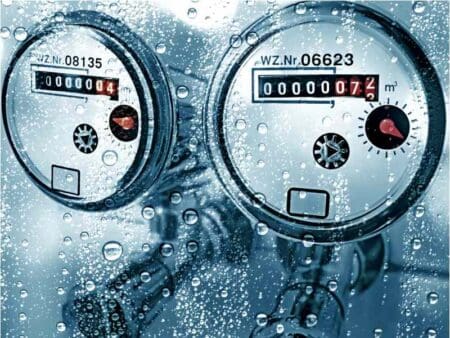
Drawing smart meters into the Internet of Things (IoT) with internet connectivity is essential to their successful deployment.
The combination of smart meters, two-way communications networks and data management systems is known as Advanced Metering Infrastructure (AMI). AMI has a variety of benefits that include helping utility companies automate device connections, meter readings and customer billing.
Smart metering, IoT connectivity and data analytics together make it easier for utilities to improve the delivery of services. The combination further makes it possible for utilities companies and their customers to work together to manage consumption and even pricing.
Smart metering and smart grids
Using various applications for centralised reading and usage tracking, gas and electricity smart metering locally monitors customers’ energy consumption. Smart meters that integrate a variety of IoT sensors are capable of collecting more and richer data in close to real-time.
The data collected by smart meters is the lifeblood of smart grids, which give utility companies the ability to aggregate and manage service delivery flows as well as monitor the health of the grid remotely and at scale. The smart grid allows utilities to deliver services sustainably, efficiently and securely, enabling them to track and achieve their climate change and carbon footprint targets.
The flow of data improves utilities’ ability to predict and monitor demand in order to manage supply. It further permits companies to share usage patterns with customers, which can represent an incentive to adopt more responsible usage practices. The benefits include quicker demand response, better-distributed resource management, operational efficiencies and improved customer relationships.
By 2030, there could be 2.2 billion smart meters deployed by electrical utilities alone, according to the Transforma Insights Connected Things TAM forecast. The adoption pattern is global, driven in part by government sustainability initiatives.
Sustainable low-power IoT devices
Another factor helping to accelerate the adoption of smart meters is the increasing availability of low power wide area network (LP-WAN) technologies, which relieve utilities from having to string a communications wire to every single smart meter. Instead, smart meters can connect to the Internet once or twice a day through a wireless LP-WAN to deliver data; the transmitters can be powered by small batteries.

Source: IoT connections market update on IoT Analytics
A safe and secure technology solution
Connectivity is key, but connections must be secure, especially in wireless networks.
There are many ways to protect smart meters and other IoT devices, but in the context of wireless networking, an important one to consider is to use a secure SIM. IoT device manufacturers are increasingly choosing the permanently fixed SIM form factor – an embedded SIM (eSIM) , or even an integrated SIM (iSIM) as part of their design.
An eSIM is a tamper-resistant chip, physically and logically isolated, offering controlled protection from the rest of a device’s processes and resources. Irremovable SIMs, whilst infinitely more physically secure, would have prevented a device from being swapped onto a new connectivity provider’s subscription. However, thanks to GSMA’s Remote SIM Provisioning (RSP) architectures and a capable, compliant SIM operating system (OS), the SIM hardware can remain securely in place whilst the carrier’s credentials and settings, the SIM profile, can be remotely added or removed securely.
The ability to verify the identity of smart meters is important. The installation of virtual private networks (VPNs) is an additional step, and security can be amplified further by implementing data encryption.
IoT SAFE is one option which offers a root of trust within the SIM on the device side. This secures a utility’s cryptography, which can be used to prove the meter’s authenticity to the utility. It can also be used to encrypt all data sent from the device.
Other advantages of eSIM
Meters often reside in restricted locations. eSIMs are of course highly integrated, so using them naturally enables designers to create compact connectivity modules.
With an eSIM, a manufacturer can select a default, out-of-the-box connectivity option, meaning they don’t have to procure multiple regional MNO SIMs or create and manage their own product variations; the default will connect to any supporting cellular network.
Available cellular connectivity options include LTE-M, NB-IoT, 2G, 3G, 4G and 5G. Operators can not only switch connectivity providers, they can also switch connectivity technologies. Fallback options are supported; should the selected network fail, connectivity can automatically get routed over an entirely different network.
Opportunities across the ecosystem
Original equipment manufacturers (OEMs) can incorporate eSIM functionality at the point of manufacture. They can then offer their utility customers a choice of cellular connectivity provision and management options.
Mobile network operators (MNOs) or MVNOs provide ‘connectivity only’ or act as an end-to-end connectivity solution enabler. The second option means they can facilitate integration or provide back-end subscription management, data traffic reporting, billing and even remote cloud management capabilities.
Connectivity management platform (CMP) providers aggregate connectivity across multiple different cellular networks, putting them in a position to manage smart meter network connectivity on behalf of utilities who are customers.
Consumers can use real-time information from their smart meters (often viewable in mobile apps or web-based dashboards) to minimise consumption or manage usage to potentially manage their billing costs.
Governments and other regulators must have accurate data to set energy usage goals and monitor progress toward achieving those goals, necessitating smart meters. Additionally, governments can also use this data to gain greater understanding of the levels of affluence and poverty across the populace, so that areas of vulnerability can be identified, and appropriate intervention measures can be adopted.
To find out more about OPEN IoT SAFE and this solution available to all smart grid players, contact Kigen at: https://kigen.com/








